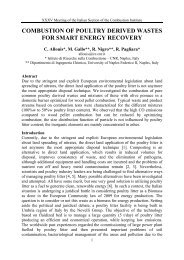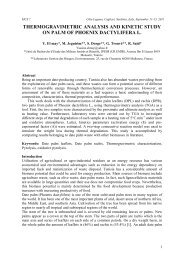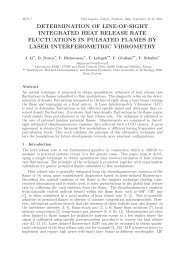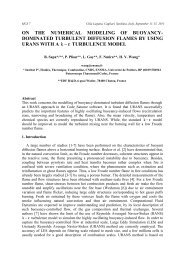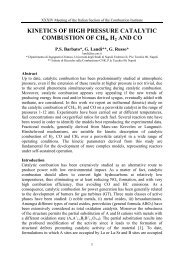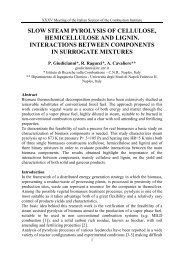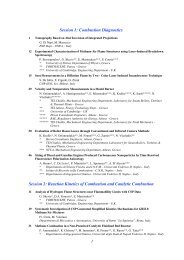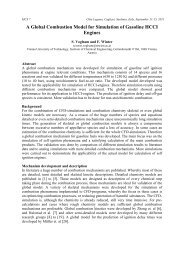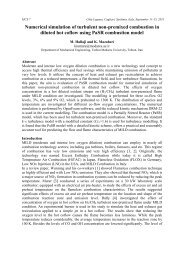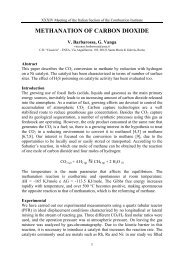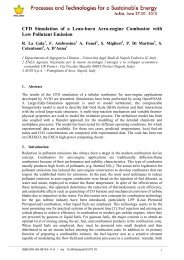seawater so2 scrubbing in a spray tower for marine application
seawater so2 scrubbing in a spray tower for marine application
seawater so2 scrubbing in a spray tower for marine application
You also want an ePaper? Increase the reach of your titles
YUMPU automatically turns print PDFs into web optimized ePapers that Google loves.
XXXV Meet<strong>in</strong>g of the Italian Section of the Combustion Institute<br />
Desulfurization efficiency, %<br />
0.000<br />
100<br />
0.002 0.004 0.006 0.008 0.010 0.012<br />
80<br />
60<br />
40<br />
20<br />
500 ppm SO 2<br />
750 ppm SO 2<br />
1000 ppm SO 2<br />
Liquid-to-gas ratio, -<br />
0<br />
0.0 0.1 0.2 0.3 0.4 0.5<br />
Liquid flow rate,m 3 /h<br />
Figure 3. Desulfurization efficiency results with <strong>seawater</strong> at different liquid flow<br />
rates and SO2 <strong>in</strong>let concentrations. Gas flow rate = 60 m 3 /h.<br />
A very important measured variable is pH, s<strong>in</strong>ce post-<strong>scrubb<strong>in</strong>g</strong> water is acidified<br />
due to the SO2 absorption process. Both fresh samples had a pH value around 7-8,<br />
while the post-<strong>scrubb<strong>in</strong>g</strong> samples had all pH < 3. Thus, <strong>in</strong> mar<strong>in</strong>e <strong>application</strong>s,<br />
spent <strong>seawater</strong> needs to be further treated be<strong>for</strong>e it can be discharged <strong>in</strong> sea.<br />
Acknowledgements<br />
The support of Nicandro Silvestri <strong>for</strong> scrubber set up, of Luca D’Addio <strong>for</strong> droplet<br />
analysis, of Fernando Stanzione <strong>for</strong> chemical analysis is gratefully acknowledged.<br />
References<br />
[1] Annex VI of MARPOL 73/78. Regulations <strong>for</strong> the prevention of air pollution from<br />
ships and NOx technical code, Inter. Maritime Organization (IMO), London, 1998.<br />
[2] An, S., Nishida, O. JSME Int. J., Series B: Fluids and Thermal Eng<strong>in</strong>eer<strong>in</strong>g, 46:206–<br />
213 (2003).<br />
[3] Andreasen, A., Mayer, S. Energy Fuels, 21:3274–3279 (2007).<br />
[4] Oikawa, K., Yongsiri, C., Takeda, K., Harimoto, T. Environ. Prog., 22:67–73 (2003).<br />
[5] Williams, P.J. “Use of <strong>seawater</strong> as makeup water <strong>for</strong> wet flue gas desulfurization<br />
systems”, EPRI-DOE-EPA Comb. Utility Air Poll. Control Symp., Aug. 16-20,<br />
Atlanta, Georgia, USA (1999).<br />
[6] Sun, X., Meng, F., Yang, F. J. Membr. Sci., 312:6–14 (2008).<br />
[7] Hufnagl, M., Liebezeit, G., Behrends,B. Effects of sea water <strong>scrubb<strong>in</strong>g</strong>, F<strong>in</strong>al report,<br />
BP Mar<strong>in</strong>e, March 2005.<br />
[8] Kircher, D., Stotz, T. “Holland America L<strong>in</strong>e sea water scrubber demonstration<br />
project”, Faster Freight, Cleaner Air, Sept. 17, Seattle, Wash<strong>in</strong>gton, USA (2008).<br />
[9] Scala, F., Lancia, A., Nigro, R., Volpicelli, G. J. Air Waste Manag. Ass., 55:20–29<br />
(2005).<br />
[10] Caiazzo, G., Di Nardo, A., Langella G., Scala, F. Environ. Prog. Sust. Energy,<br />
31:277-287 (2012).<br />
10.4405/35proci2012.VI14<br />
6



